义务教育人教版英语易错易混考点归纳记忆顺口溜(形容词和副词的比较级和最高级)
- 格式:docx
- 大小:23.10 KB
- 文档页数:2

形容词和副词的比较级和最高级笔记在英语学习中,形容词和副词的比较级和最高级是非常重要的语法点。
它们能够帮助我们更准确、生动地表达程度和数量的差异。
接下来,让我们一起来详细了解一下。
一、比较级的构成大多数单音节形容词和部分双音节形容词,在词尾加 er 构成比较级。
比如:tall taller,short shorter,young younger。
以不发音的 e 结尾的单音节形容词,直接加 r 构成比较级。
例如:nice nicer,large larger。
重读闭音节词,且词尾只有一个辅音字母时,要先双写这个辅音字母,再加 er 。
比如:big bigger,hot hotter,thin thinner 。
多音节形容词和部分双音节形容词,在前面加 more 构成比较级。
例如:beautiful more beautiful,important more important 。
二、比较级的用法1、两者之间的比较A + be +形容词比较级+ than +B ,表示“A 比 B 更……”。
例如:He is taller than me(他比我高。
)A +实义动词+副词比较级+ than +B ,表示“A 做某事比 B 更……”。
例如:She runs faster than him(她跑得比他快。
)2、比较级+ and +比较级,表示“越来越……”。
例如:It's getting colder and colder(天气变得越来越冷。
)3、The +比较级,the +比较级,表示“越……,越……”。
例如:The more you read, the more knowledge you will get(你读得越多,你获得的知识就越多。
)4、可以用 much、a little、a lot、even、far 等修饰比较级,加强比较的程度。
例如:He is much taller than me(他比我高得多。
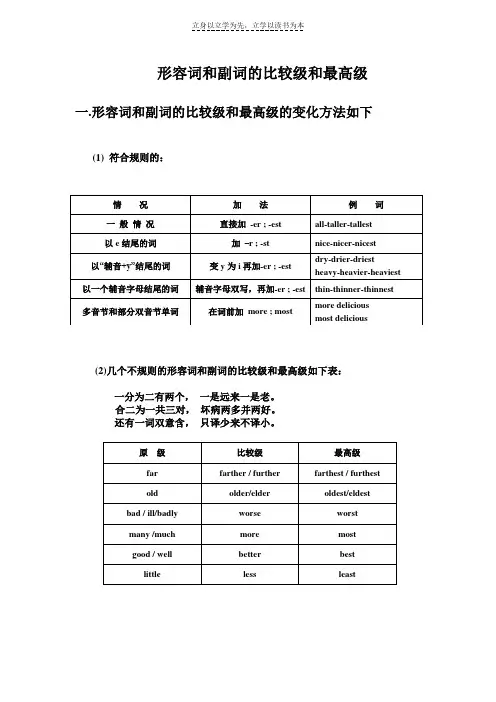
形容词和副词的比较级和最高级一.形容词和副词的比较级和最高级的变化方法如下(1) 符合规则的:(2)几个不规则的形容词和副词的比较级和最高级如下表:一分为二有两个,一是远来一是老。
合二为一共三对,坏病两多并两好。
还有一词双意含,只译少来不译小。
二.形容词和副词比较级的用法注意:有些形容词,如dead, empty, round, sure, woolen等受本身含义的限制,没有比较级。
例题解析1. He is ________ friends than I.A. much moreB. many moreC. very moreD. too more解析:后面有可数名词复数时,many的比较级形式为many more 修饰。
应选B.2. Which is the _________ country, Japan or Australia?A. more developedB. more developingC. most developedD. most developing解析:两者比较用比较级,表示"发达"用developed, 而developing 是"发展中的" 意思3. There were _______ shops in the city in 1982 than in 1990.A. littleB. fewC. fewerD. less解析:little 不能修饰可数名词,两者比较需用比较级,所以应选C.4. If you are not free today, come another day __________.A. tooB. soC. insteadD. yet解析:instead 作副词用时意为"代替,顶替",表示前面的事情没做,而是做了后面的事。
Instead一般位于句首。
应选C.5.He can't tell us ________, I think.A. important anythingB. anything importantC. important somethingD. something important.解析:不定代词与形容词联用需后置,否定句中应该用anything而不是something. 因此应选B6. The Huang River is the second __________ river in our country.A. longB. longerC. longestD. the longest解析:"定冠词the+ 序数词+ 形容词最高级" 表示"第几大……" 应选C.7. The light in the office wasn't ________for him to read.A. enough brightB. bright enoughC. brightlyD. enough brightly解析:enough修饰名词时可前可后,修饰形容词或副词时,要后置。
形容词和副词的比较级和最高级一。
形容词和副词的比较级和最高级的变化方法如下(1) 符合规则的:(2)几个不规则的形容词和副词的比较级和最高级如下表:一分为二有两个,一是远来一是老.合二为一共三对,坏病两多并两好。
还有一词双意含,只译少来不译小。
二.形容词和副词比较级的用法注意:有些形容词,如dead, empty, round, sure, woolen等受本身含义的限制,没有比较级。
例题解析1。
He is ________ friends than I。
A。
much more B. many more C. very more D。
too more解析: 后面有可数名词复数时,many的比较级形式为many more 修饰。
应选B。
2. Which is the _________ country, Japan or Australia?A. more developed B。
more developing C。
most developed D。
most developing解析:两者比较用比较级,表示"发达”用developed, 而developing 是"发展中的" 意思3. There were _______ shops in the city in 1982 than in 1990.A. little B。
few C。
fewer D. less解析:little 不能修饰可数名词,两者比较需用比较级,所以应选C.4. If you are not free today, come another day __________。
A。
too B. so C. instead D。
yet解析:instead 作副词用时意为"代替,顶替”, 表示前面的事情没做,而是做了后面的事。
Instead一般位于句首。
应选C。
5.He can’t tell us ________, I think。
少儿英语语法口诀:形容词和副词比较级形容词和副词的比较等级及用法句型口诀:一者比较用原级。
比较级限二者比。
三者三者往上比,级的用法起。
若要比项掌握齐,比较范围要搞细。
比较级二句型记,做出句子没问题。
若甲乙水准相同,as…as 结构体。
甲某方面不及乙,用 notso/as…as表示。
上述内容全记起,比较等级谈完毕。
------------------------------英文中的形容词和副词一般都有三种级的形式即:原级(The Positive Degree),比较级(The Comparative Degree)和级(The Superlative Degree)。
1) 同级比较往往由"as + 形容词/ 副词的原形 + as"的句式表达;当然也要注意它的否定形式、以及在第一个as前加倍数或水准副词的情况。
2)"比较级 + than"引导不同级的比较。
"比较级" 前同样能够加倍数或水准副词。
另外"no more …than"意思是"A和B一样不……" 。
3) 形容词的级前一般必须有定冠词the;但是也有不加定冠词the的几种情况。
一、同级比较中有两种情况:A 表示双方情况"一模一样",用as + 原级 + as的结构;B 表示双方情况"不(那么)一样",用not so / as + 原级 + as的结构。
在这两种结构中,第一个as是副词,而第二个as是连词;在第二个as的后面接名词、句子或代词的主格(一般不要接代词的宾格)。
例如:My parcel is as heavy as yours . 我的包裹与他的一样沉。
His bedroom is not as neat as his sister's. 他的卧室没有他姐姐的整洁。
It is not so hot as yesterday. 今天不象昨天那么热。
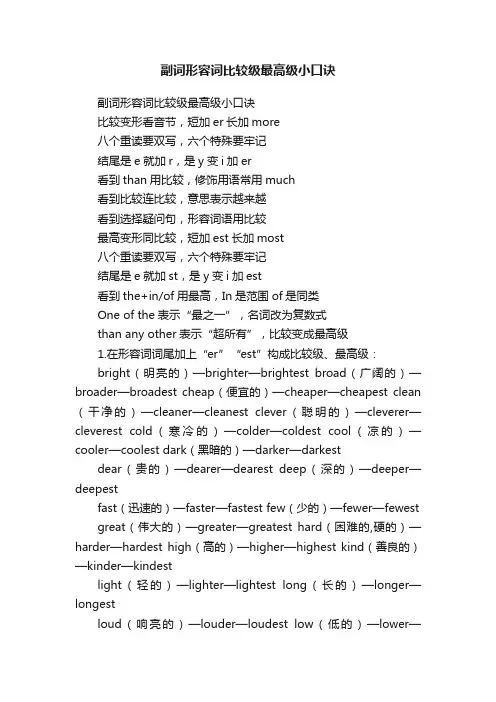
副词形容词比较级最高级小口诀副词形容词比较级最高级小口诀比较变形看音节,短加er长加more八个重读要双写,六个特殊要牢记结尾是e就加r,是y变i加er看到than用比较,修饰用语常用much看到比较连比较,意思表示越来越看到选择疑问句,形容词语用比较最高变形同比较,短加est长加most八个重读要双写,六个特殊要牢记结尾是e就加st,是y变i加est看到the+in/of用最高,In是范围of是同类One of the表示“最之一”,名词改为复数式than any other表示“超所有”,比较变成最高级1.在形容词词尾加上“er”“est”构成比较级、最高级:bright(明亮的)—brighter—brightest broad(广阔的)—broader—broadest cheap(便宜的)—cheaper—cheapest clean (干净的)—cleaner—cleanest clever(聪明的)—cleverer—cleverest cold(寒冷的)—colder—coldest cool(凉的)—cooler—coolest dark(黑暗的)—darker—darkestdear(贵的)—dearer—dearest deep(深的)—deeper—deepestfast(迅速的)—faster—fastest few(少的)—fewer—fewest great(伟大的)—greater—greatest hard(困难的,硬的)—harder—hardest high(高的)—higher—highest kind(善良的)—kinder—kindestlight(轻的)—lighter—lightest long(长的)—longer—longestloud(响亮的)—louder—loudest low(低的)—lower—lowestnear(近的)—nearer—nearest new(新的)—newer—newestpoor(穷的)—poorer—poorest quick(快的)—quicker—quickestquiet(安静的)—quieter—quietest rich(富裕的)—richer—richestshort(短的)—shorter—shortest slow(慢的)—slower—slowestsmall(小的)—smaller—smallest smart(聪明的)—smarter—smartest soft(柔软的)—softer—softest strong(强壮的)—stronger—strongest sweet(甜的)—sweeter—sweetest tall(高的)-taller-tallestthick(厚的)—thicker—thickest warm(温暖的)—warmer—warmest weak(弱的)—weaker—weakest young(年轻的)—younger—youngest 2.双写最后一个字母,再加上“er”“est”构成比较级、最高级:big(大的)—bigger—biggest fat(胖的)—fatter—fattesthot(热的)—hotter—hottest red(红的)—redder—reddestsad(伤心的)—sadder—saddest thin(瘦的)—thinner—thinnestwet(湿的)—wetter—wettest mad(疯的)—madder—maddest3.以不发音的字母e结尾的形容词,加上“r”、“st”构成比较级、最高级:able(能干的)—abler—ablest brave(勇敢的)—braver—bravestclose(接近的)—closer—closest fine(好的,完美的)—finer—finestlarge(巨大的)—larger—largest late(迟的)—later—latestnice(好的)—nicer—nicest ripe(成熟的)—riper—ripestrude(粗鲁的)—ruder—rudest safe(安全的)—safer—safeststrange(奇怪的)—stranger—strangest wide(宽广的)—wider—widestwise(睿智的,聪明的)—wiser—wisest white(白的)—whiter—whitest4.以字母y结尾的形容词,把y改为i,再加上“er”、“est”构成比较级、最高级:busy(忙碌的)—busier—busiest dirty(脏的)—dirtier—dirtiestdry(干燥的)—drier—driest early(早的)—earlier—earliesteasy(容易的)—easier—easiest friendly(友好的)—friendlier—friendliestfunny(好玩的)—funnier—funniest happy(开心的)—happier—happiest healthy(健康的)—healthier—healthiest heavy(重的)—heavier—heaviest hungry(饿的)—hungrier—hungriest lazy(懒惰的)—lazier—laziestlucky(幸运的)—luckier—luckiest naughty(调皮的)—naughtier—naughtiest noisy(嘈杂的)—noisier—noisiest pretty (美丽的)—prettier—prettiestsilly(傻的)—sillier—silliest spicy(辣的)—spicier—spiciest thirsty(渴的)—thirstier—thirstiest ugly(丑的)—uglier—ugliest5.双音节、多音节形容词,在单词前面加上“more”“most”构成比较级、最高级:afraid(害怕的)—more afraid—most afraid beautiful(美丽的)—more beautiful—most beautifulcareful(仔细的)—more careful—most carefulcheerful(开心的)—more cheerful—most cheerfulcrowded(拥挤的)—more crowded—most crowdeddangerous(危险的)—more dangerous—most dangerous delicious(美味的)—more delicious—most deliciousdifficult(困难的)—more difficult—most difficultexciting(令人兴奋的)—more exciting—most excitingexpensive(昂贵的)—more expensive—most expensivefamous(著名的)—more famous—most famousfrightened(受惊的)—more frightened—most frightened frightening(令人害怕的)—more frightening—most frighteninghard-working(勤奋的)—more hard-working—most hard-workinghelpful(有帮助的)—more helpful—most helpfulhonest(诚实的)—more honest—most honestimportant(重要的)—more important—most importantinteresting(有趣的)—more interesting—most interesting polite(有礼貌的)—more polite—most politeterrible(可怕的)—more terrible—most terribletired(累的)—more tired—most tired6.不规则变化的形容词:good(好的)/ well(好的)—better—bestbad(坏的)/ badly(坏的)/ ill(病的)—worse—worstmany(多的)/ much(多的)—more—mostlittle(少的)—less—leastold(老的)—older/ elder—oldest/ eldestfar(远的)—farther/ further—farthest furthest。
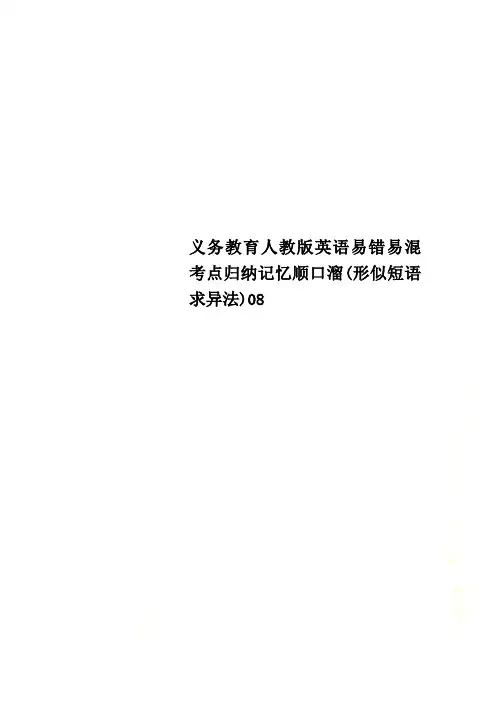
义务教育人教版英语易错易混考点归纳记忆顺口溜(形似短语求异法)08
轻介连代冠重复,
系助情肯常弱读。
(54) 肯定句some(-),
问句表请求;
问否句any(-),
肯句任何一,
every(-)肯否问任意,
no(-)肯句否定意。
(55) 形容修不代后置,
不代形如分子式;
先说写后,
后说写前,
重要事,
好东西,
其他的某些人。
(56) 介后代宾动名式最广,
in, at, by, for, on;
with, up, of, from;
to后代宾/动名ing用上。
(57) 在两侧三表达,
on后复名both sides,
单名each side或either side.
(58) what问职业事所干,
who/whom主宾谁人员,
where问大小地点,
whose谁的问归属权。
how many多少复名跟后边,
how much多少不可名与钱。
why问原因简要谈,
what time问具体时间是几点,
when问笼统时间日月年,
how old问岁数多大年,
how is/are人身体是否健!。
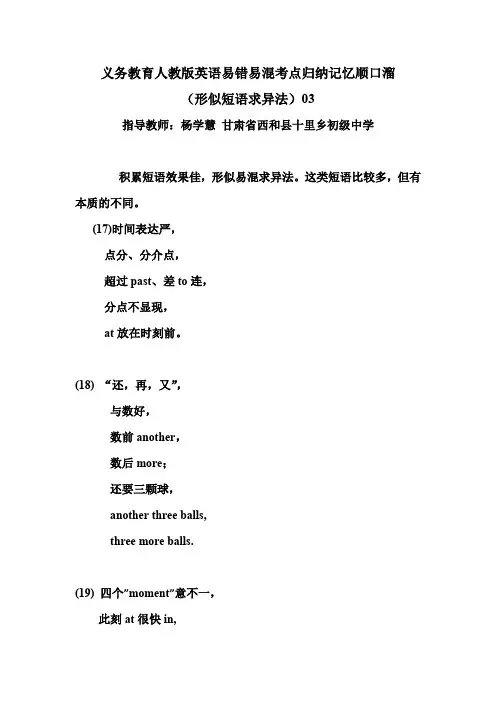
义务教育人教版英语易错易混考点归纳记忆顺口溜(形似短语求异法)03指导教师:杨学慧甘肃省西和县十里乡初级中学积累短语效果佳,形似易混求异法。
这类短语比较多,但有本质的不同。
(17)时间表达严,点分、分介点,超过past、差to连,分点不显现,at放在时刻前。
(18) “还,再,又”,与数好,数前another,数后more;还要三颗球,another three balls,three more balls.(19) 四个”moment”意不一,此刻at很快in,ago刚才,for一会儿。
(20)few接复名,little不可名,有a有些/有一点,无a几乎都没有;有a反问用否定,无a反问用肯定。
(21) 三个“到达”两带介,arrive接地in /at,接地带to用get,reach接地很便捷;遇到这那家,省介三“到达”。
(reach、arrive、get后遇here、there、home时,不用任何介词。
)(22)两个“穿过”朋友广,across 横过山河桥街场,through穿过门林洞璃廊。
(23) have gone, have gone,某人已去往,至今未返回,where/just/isn’t here/will/hasn’t come来帮忙;have been, have been,某人已去过某地,现在已返回,ever/never/before/twice常搭配。
(24) play后接人,和……比赛;后接球类不用the,打/踢…球;后接乐器必加the,弹/拉/奏;play with 与某人/物玩耍;play music演奏音乐。
义务教育人教版英语易错易混考点归纳记忆顺口溜(形似短语求异法)07积累短语效果佳,形似易混求异法。
这类短语比较多,但有本质的不同。
(41) 忘丢东西在某地left ... in/at,忘事忘物无场地forgot.(42) 知道know/是be/喜欢like,想要want/爱love/祝愿wish,希望hope/认为think/信believe过现。
(43) the end“末尾”四用法,末/底at, 到…为止by,最后用in, 结束to,用对介词区别它。
(44) 四伤害两损坏,hurt肉体伤害=injure,harm身心伤害,wound器械伤害,damage和destroy房屋/车辆被损坏。
(45) whole和all的用法whole位于冠限词之后,all位于冠限词之前。
the前all,the后whole.(46) high山高,楼高, 粗壮物体高,tall个高,树高,细长物体高。
(47)family指家/家庭时,系动is或动单三加s/es,如Her family is a happy one.family指家庭成员时,系are或动原,或are doing,如My family are all watching TV.(48)it指代前面提到过的同类同物。
one代替前面提到过的同类异物,也指人。
one的复数式ones。
one和ones指人或物,one和ones前不用物代。
that/that of代替前面提到过的同类东西,指人口/天气/价格/故事/文章,不指人。
that代替上文全句的内容,it和one则不能。
those替代与前面提到过的同类同复物,ones 代替前面提到过的同类异复物;the ones和those可互换。

义务教育人教版英语易错易混考点归纳记忆顺口溜(形似短语求异法)02积累短语效果佳,形似易混求异法。
这类短语比较多,但有本质的不同。
(9) 四“也”用法各自有,also动前系情后,肯句加逗再带too;either跟在not否句后,as well紧跟并列and后词后。
(10) too much(太多)修动或名,much too(太)修形容,前too太多后too太,按意选用最妙快。
(11) 三“借”介各需,from巧遇borrow入,遇to快把lend出,见for//how long用keep.(12)long与before组合定时态,before long和long before;long在前(很久前),was/were或动ed过去变;long在后(不久后),将来will+动原,或be going to+动原。
(13)四个“穿上”来回演,have on/wear衣服着身间,be dressed in后颜色鲜(显),这两同义互替换,put on拿起衣服身上穿,dress套装女服反代选,dress up过节会乔装又打扮。
(14)in, on, at两地位置关系:两地位置里邻远,里in邻on远离to.(15)fill和full意“充满”,唯独介词管它严,with跟着fill转,of常把full照看,吃饱没饱full抢先。
(16)“远”有两用法,有数用away,无数要用far,It’s far from here.离这儿远。
far away from home远离家。
义务教育人教版英语易错易混考点归纳记忆顺口溜(形似短语求异法)01指导教师:杨学慧甘肃省西和县十里乡初级中学积累短语效果佳,形似易混求异法。
这类短语比较多,但有本质的不同。
①后复名/不可名用a lot of,前有动词后无名用a lot.(For example:eat a lot of food与eat a lot.)② too much(太多)修动或名,much too(太)修形容;前too太多后too太,按意选用最妙快;(For example:too much homework与much too difficult/easy.)③ long与before组合定时态,before long和long before;long在前(很久前),was/were或动ed过去变;long在后(不久后),将来will+动原,或be going to+动原。
④ the end(末尾)四用法,末/底at, 到…为止by,最后用in, 结束to,用对介词区别它。
(in the end =at last =finally最后,最终;at the end of在…末/结束;by the end of到….末为止,在….结束前;to the end结束,到底。
)⑤some、time俩朋友,多次时约时分手。
两厢情愿来约会sometime,相约“某一时”;(将来式)话不投机又分离some time,分离“一段时”; (过去式)短信联系续相思sometimes,单思“偶、有时”;(般现、过去)失恋分手单相思some times,失恋“好几次”。
(现完式)⑥go +动名词ing类:去游泳/购物/游山玩,滑冰/滑雪/钓鱼/去划船,骑车/野营/观光/把步散,go后这些动词加ing变。
(go swimming去游泳, go shopping去购物,go hiking去远足/去游山, go skating去滑冰,go skiing去滑雪, go fishing去钓鱼,go boating去划船, go walking去散步,go sightseeing去观光, go camping去野营,go bike riding去骑车….)⑦“喜欢做”六七个,无论哪个别用错。
形容词和副词的比较级和最高级一.形容词和副词的比较级和最高级的变化方法如下(1) 符合规则的:(2)几个不规则的形容词和副词的比较级和最高级如下表:一分为二有两个,一是远来一是老。
合二为一共三对,坏病两多并两好.还有一词双意含,只译少来不译小。
二.形容词和副词比较级的用法注意:有些形容词,如dead, empty, round, sure, woolen等受本身含义的限制,没有比较级。
例题解析1。
He is ________ friends than I。
A. much more B。
many more C. very more D。
too more解析:后面有可数名词复数时,many的比较级形式为many more 修饰。
应选B。
2。
Which is the _________ country,Japan or Australia?A。
more developed B。
more developing C. most developed D. most developing 解析:两者比较用比较级,表示"发达”用developed, 而developing 是”发展中的”意思3. There were _______ shops in the city in 1982 than in 1990.A。
little B。
few C. fewer D。
less解析:little 不能修饰可数名词,两者比较需用比较级, 所以应选C。
4. If you are not free today,come another day __________。
A。
too B. so C。
instead D。
yet解析:instead 作副词用时意为"代替,顶替",表示前面的事情没做,而是做了后面的事。
Instead一般位于句首。
应选C。
5.He can’t tell us ________,I think。
义务教育人教版英语易错易混考点归纳记忆顺口溜(同类结构归纳)指导教师:杨学慧甘肃省西和县十里乡初级中学不规则中找规律,实践提炼概括法。
⑴doing类:禁止做no doing、介in/on/at/for/of/with doing、喜爱做like/enjoy doing、去做go doing、做完finish doing,坚持做keep doing/kept on doing,继续做go on doing/went on doing/continue doing、忙于做be busy doing,忍不住做can't help doing,感谢你/你们做thank you for doing/thanks for doing/thanks a lot for doing、更喜欢做prefer doing,成功做某事succeed in doing/be successful in doing,练习做practice doing,开心地做某事have fun doing,想做feel like doing、介意做mind doing,花时钱做某事spend time/money doing,费力做某事have trouble/difficulties in doing,做事结束end up doing,放弃做give up doing,阻止做某事stop ...from doing/keep...from doing/prevent...from doing。
简言:禁、介、喜爱2、去、做完,坚持2、继续3、忙于做,忍不住,感谢4、更喜欢,成功2、练习、开心地做,想做、介意、花时钱,费力、结束、放弃做,阻止3后动名ing连。
⑵to do类(不定式)①有事要做have sth. to do/There is/are 事情to do、请ask(叫tell/told、要want、花费takes/took)人sb to do,太...而不能做too 形to do,足够做(形)enough to do,该做某事的时候了It’s time(for sb) to do,动/动短+不定式,愿意做would like to do、要做某事(不定代词+不定式)something to do、对某人来说做某事怎么样It is(was) 形容for sb to do,疑问词what /when/where/how to do,为了做某事to do/in orger to do/so as to do、某人的工作/爱好/目标是做...one’s job(work/hobby/aim) is to do,第一个(最后一个)做某事的人sb is the first/last to do sth,发现做某事很难find/found it difficult to do,认为做某事怎么样think it 形容词to do,②想要做want to do,愿意做would like to do、希望做hope to/wish to do、敢做dare to do、鼓励做encourage to do,需要做need to do、计划做plan to do,来做come to do、学做study to/learn to do,打算做be going to/mean to do、答应做promise to do、去某处做go/went to 某处to do、建议做suggest/proposeto do,别忘了做某事don't forget to do、决定做decide to do /make up one's mind to do、准备做get ready to do/prepare to do、记着做remember to do,要求做urge/require/demand to do、教人做teach/taught sb to do sth、邀请某人做invite sb to do、命令/警告某人做order/ warn sb to do sth.③过去常常做used to do、迫不及待地做can’t wait to do,应该做ought to do/be supposed to do、与...有关have something/nothing to do with、没钱做某事can’t afford to do,宁愿做...而不愿做prefer to do...rather than do、尽力做do/try one's best to do、有能力做be able to do、最好做某事It’s better/best to do sth,允许做某事allow to do/be allowed to do、期待做某事expect to do、会做learn to do、有钱做某事can afford to do.简言之:①有事、请(叫、要、花费)人,too 形、够做、时、动短,愿意、不代、it is形for人,疑问词、为了、工作is 、第一人,发现、认为做某事it 形容怎么样,这些词后用不定式to 动原。
47.形容词、副词比较级与最高级部分用法歌诀(1)两者和三者或三者以上比较歌诀:两者比较用than连,三者比较the在前。
例句:My father is old.He is elder than my mother.Grandmother is the eldest in my family.我父亲老了。
他比我母亲老,奶奶是我们家中最老的。
(2)同级比较歌诀:同级比较用原级, as…as永不离。
若是否定加not, as…as否前者。
as…as加not,只说两者有区别。
so…as加not,后者总是强前者。
例句:1)Maths is as interesting as English.数学和英语一样有趣。
Maths is not so interesting as English.数学没有英语有趣。
Maths is not as interesting as English.数学和英语不一样有趣。
2)Li Ping runs as fast as Li Hua.李平和李华跑得一样快。
Li Ping does not run so fast as Li Hua.李平没有李华跑得快。
Li Ping does not run as fast as Li Hua.李平和李华跑得不一样快。
(3)比较级的程度歌诀:Much、still、a lot、far,Even、twice、a little加,“三年”“五月”any—“更”, a great deal深一层。
说明:比较级前可用以上词修饰,但不可用many,too,so等词修饰。
这些词常用来表示比较级的程度,其词义分别为:much……得多;still要、还要;a lot……得多,far 远为、得多;even更、还要;twice两倍,a little稍微;three years 三年;five months五月;更、再;a great deal得多。
再看几个例句:1)We have a much better life now. We must make it better still.我们现在的生活好多了。
义务教育人教版英语易错易混考点归纳记
忆顺口溜
(形容词和副词的比较级和最高级)
指导教师:杨学慧甘肃省西和县十里乡初级中学
形副比较等级概括法
一原(原级/原形)二比(er)三最高(est),
much/even/a little/a lot/no/any +比较+than,
of all/in/among短语前the最高,
of the two句the比较,
of the three句the最高;
多音节比more +原级,
最the most+原级,
比较级,A or B?
the最高,A,B or C?
the序数最高级,
one of the 最高复名,
不规比最熟记心;
A和B一样,
A is as 原as B.
不一样,A isn’t as(so)原as B.
B is a little/much 比较than A.
越来越…比and 比,
from原to比;
越…,就越….The 比两句并,
前句般现后将来。
不规则形副词比最串记法:
形副好good/well,更好better,最好best;
病/坏/糟ill/bad/badly,更糟worse,最糟worst;
多many/much/some,更多more,最多most;
少/小/有一点little/a little,更小/少less,最小/少least;
far/fur比最尾加the再变,更远farther,最远farthest;另外,更进一步further,furthest。